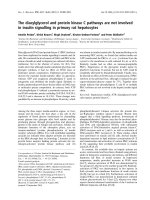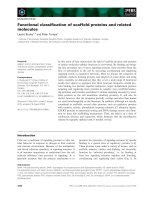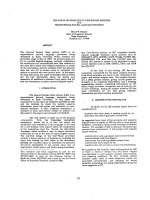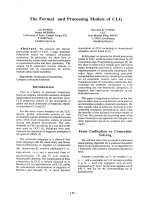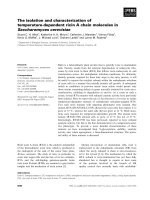báo cáo khoa học: " The gene map of the rabbit α and β casein gene synteny" pps
Bạn đang xem bản rút gọn của tài liệu. Xem và tải ngay bản đầy đủ của tài liệu tại đây (762.83 KB, 6 trang )
Note
The
gene
map
of
the
rabbit
III.
α
and
β
casein
gene
synteny
M.
DALENS,
J.
GELLIN
LN.R.A.,
Laboratoire de
Ggng
tique
Cellulaire,
B.P.
27,
F
31326
Castanet-Tolosan
Cedex
Summary
We
are
developing
the
gene
map
of
the
rabbit
using
DNA
probes
which
allow
us
to
investigate
non-expressed
genes.
We
have
characterized
an
a
and
(i casein
gene
synteny
and
have
found
that
neither
the
a
and
casein
genes
nor
the
whey
acidic
protein
gene
have
a
syntenic
relationship
with
the
other
chromosome
markers
already
investigated
in
our
laboratory.
Moreover,
with
the
casein
probe
we
have
detected
a
simple
allelic
Eco
RI
restriction-site
polymorphism.
Key
words :
Rabbit,
gene
mapping,
a
and
(3 casein
genes,
whey
acidic
protein
gene,
DNA
polymorphism.
Résumé
Carte
génique
du
lapin.
111.
Synténie
entre
les
gènes
des
caséines
a
et
f3
Nous
développons
la
carte
génique
du
lapin
en
utilisant
des
sondes
d’ADN
cloné
qui,
par
hybridation
moléculaire,
permettent
de
caractériser
les
gènes
indépendamment
de
leur
expression.
Dans
le
cadre
de
cette
étude,
nous
avons
mis
en
évidence
une
synténie
entre
les
gènes
de
la
caséine
a
et
de
la
caséine
!3.
Aucune
relation
de
synténie
n’a été
observée
entre
les
gènes
des
caséines
a
et
(3,
ou
le
gène
de
la
protéine
acide
du
lactosérum
et
les
autres
marqueurs
chromosomiques
déjà
étudiés
au
laboratoire.
Les
résultats
obtenus
avec
la
sonde
caséine
p
montrent
un
polymorphisme
au
locus
de
ce
gène
sous
la
dépendance
d’un
couple
d’allèles.
Mots
clés :
Lapin,
carte
génique,
gènes
des
caséines
a
et
!3,
gène
de
la
protéine
acide
du
lactosérum,
polymorphisme
de
l’ADN.
I.
Introduction
Assignment
of
at
least
one
marker
per
chromosome
is
one
of
the
objectives
of
gene
mapping.
By
molecular
hybridization
of
nucleic
acid,
one
can
analyse
non-
expressed
genes
and
thus
get
access
to
a
large
number
of
valuable
chromosome
markers.
The
present
results
demonstrate
that
the
a
and
f3
casein
genes
are
syntenic
in
New
Zealand
rabbits.
Taking
into
account
the
previous
results
obtained
with
DNA
probes
or
enzyme
markers,
we
find that
a
and
f3
casein
genes
and
the
whey
acidic
protein
gene
are
not
syntenic
with
any
of
the
20
other
chromosome
markers
already
investigated
in
our
laboratory.
II.
Materials
and
methods
A.
Biological
material
The
rabbit
x
Chinese
hamster
somatic
cell
hybrids
used
in
this
study
have
been
previously
described
(E
CHARD
et
al. ,
1981).
Among
3
independent
series
of
hybrid
clones,
26
clones
were
chosen
on
the
basis
of
their
growth
ability
and
low
chromosome
number.
B.
Molecular
hybridization
Purification
of
high
molecular
weight
cellular
DNA,
total
digestion
with
endonu-
clease
Eco
RI,
agarose
gel
electrophoresis,
transfer
onto
nitrocellulose
filters,
nick-
translation
of
the
probes
and
DNA/DNA
hybridization
were
performed
as
previously
described
(G
ELLIN
et
al.,
1983).
The
probes
used :
a
casein,
f3
casein,
and
whey
acidic
protein
(WAP),
were
from
a
lactating
rabbit
mammary
gland
cDNA
library
(S
UARD
et
al.,
1982).
C.
Synteny
analysis
Synteny
analysis
was
performed
between
the
3
new
markers
and
the
markers
already
studied
in
our
laboratory :
enzymatic
markers
(E
CHARD
et
al.,
1982)
and
uteroglobin
gene
(G
ELLIN
et
al.,
1983).
III.
Results
and
discussion
A.
Syntenic
studies
Eco
RI
digested
DNA
from
rabbit
or
hamster
cells
and
rabbit
x
hamster
hybrid
clones,
was
hybridized
with
a
casein,
(3
casein
and
WAP
radioactive
probes.
In
our
experimental
conditions,
no
cross-hybridization
was
observed
between
a
and
(3
casein
probes,
nor
between
the
2
probes
and
the
hamster
DNA.
Hybridization
of
the
a
casein
probe
with
rabbit
DNA
from
cells
or
hybrid
clones
gave
3
bands
at
9.2
kilobases
(kb),
5.8
kb
and
4
kb
(fig.
1) ;
the
f3
casein
probe
gave
3
different
band
patterns :
11
kb,
8.6
kb and
11
kb
+
8.6
kb
(fig.
1
and
fig.
2).
The
f3
casein
polymorphism
observed
in
the
hybrid
clones
reflects
the
polymorphism
of
the
parental
rabbit
cells
as
will
be
discussed
below.
The
WAP
probe
gave
bands
of
different
size
in
hamster
and
rabbit
DNA.
It
is
always
possible
to
determine
if
the
rabbit
fragment
is
present
or
not
in
hybrid
clones (fig. 1).
Table
1
shows
the
correlation
analysis
of
the
results
obtained
by
hybridization
of
the
3
cDNA
probes
with
the
somatic
hybrid
cellular
DNAs.
Among
26
hybrid
clones
tested
for
a
and (3
casein
genes,
the
same
14
were
positive
and
the
same
10
negative
for
both
casein
probes.
This
shows
that
these
2
genes
are
syntenic.
Such
casein
gene
synteny
was
already
described
in
cattle
by
linkage
analysis
(G
ROSCLAUDE
,
1979)
and
in
mice
by
molecular
hybridization
(G
UPTA
et
al.,
1982).
No
synteny
was
found
between
casein
genes
and
the
WAP
gene.
By
computer
analysis
(C
ORPET
et
al.,
in
preparation)
of
the
present
results
and
those
previously
obtained
in
our
laboratory,
we
could
not
find
any
syntenic
relationship
between
the
other
rabbit
chromosome
markers
and
the
a
casein,
f3
casein
or
WAP
genes.
We
have
now
4
syntenic
groups
(a
and (3
casein
genes ;
ACP.2-LDH.A
and
uteroglobin
gene ;
LDH.B-TPI
and
GAPDH ;
G6PD-PGK-HPRT
and
GLA)
plus
11
independent
asyntenic
markers
to
mark
14
autosomal
chromosomes
and
the
X
chromo-
some
among
the
22
chromosome
pairs
of
the
rabbit.
Nine
linkage
groups
and
3
more
syntenic
groups
have
been
described
by
FOX
(in
Genetic
Maps,
1984).
B.
Detection
of
an
Eco
RI
restriction-site
polymorphism
with
the
!3
casein
probe
Using
the
f3 casein
probe
we
observed
3
hybridizing
patterns
depending
on
the
rabbit
DNA
tested :
either
one
fragment
at
11
kb
(rabbits
L2910
and
L4),
one
fragment
at
8.6
kb
(rabbits
LM1,
L2
and
Ll)
or
both
fragments
11
kb
+
8.6
kb
(rabbits
L2109,
L5
and
L3)
(fig.
2).
Among
the
16
hybrid
clones
having
kept
at
least
one
rabbit
!3
casein
gene,
we
observed
the
same
pattern
in
the
cell
hybrids
as
in
the
rabbit
parental
cells :
i.e.
an
11
kb
fragment
for
5
hybrid
clones
obtained
from
a
rabbit
displaying
the
11
kb
fragment
and
an
8.6
kb
fragment
for
7
hybrid
clones
derived
from
a
rabbit
displaying
the
8.6
kb
fragment.
Among
the
4
hybrid
clones
derived
from
a
rabbit
having
both
fragments,
3
hybrid
clones
presented
both
fragments
and
the
fourth
showed
only
the
11
kb
fragment.
In
this
last
case,
the
homologous
chromosome
bearing
the
8.6
kb
fragment
may
have
been
lost.
It
therefore
appears
that
a
simple
allelic
Eco
RI
restriction-site
polymorphism
does
exist.
Further
characterization
of
this
polymor-
phism
is
in
progress.
Acknowledgements
We
thank
Dr.
J.P.
K
RAEHENBUHL
who
has
built
the
C
DNA
library
and
authentified the
recombinant
clones
used
as
probes
and
Dr.
E.
D
EV
iNOY
who
has
selected
these
clones
from
the
library.
The
rabbits
used
in
this
study
were
obtained
from
the
S.A.G.A.
(I.N.R.A.,
C.R.
de
Toulouse),
courtesy
of
F.
T
UDELA
.
Received
December
12,
1983.
Accepted
July
23,
1985.
References
E
CHARD
G.,
G
ELLIN
J.,
B
ENNE
F.,
G
ILLOIS
M.,
1981.
The
gene
map
of
the
rabbit.
I.
Synteny
between
the
rabbit
gene
loci
coding
for
HPRT,
PGK,
G6PD,
and
GLA.
Their
localisation
on
the
X-chromosome.
Cytogenet.
Cell
Genet.,
29,
176-183.
E
CHARD
G.,
G
ELLIN
J.,
B
ENNE
F.,
G
ILLOIS
M.,
1982.
The
gene
map
of
the
rabbit.
II.
Analysis
of
the
segregation
of
11
enzymes
in
rabbit
x
hamster
somatic
cell
hybrids :
two
syntenic
groups,
LDHB-TPI
and
LDHA-ACP2.
Cytogenet.
Cell
Genet.,
34,
289-295.
Fox
R.,
1984.
Linkage
map
of
the
rabbit
(Oryctolagus
cuniculus).
In :
O’B
RIEN
,
Genetic
Maps,
Vol.
3,
396-400.
Cold
Spring
Harbor
Lab.
G
ELLIN
J.,
D
ALENS
M.,
E
CHARD
G.,
H
ATEY
F.,
1983.
Carte
génique
du
Lapin
(Oryctolagus
cuniculus
L.) :
Synténie
entre
les
genes
ut6roglobine,
lactate
déshydrogenase
A
et
phospha-
tase
acide
2.
Genet.
S61.
Evol.,
15,
399-494.
G
ROSCLAUDE
F.,
1979.
Polymorphism
of
milk
proteins :
some
biochemical
and
genetical
aspects.
Proceedings
of
the
l6th
International
Conference
on
animal
blood
groups
and
biochemical
polymorphisms.
Leningrad
1978,
Vol.
1,
54-92.
G
UPTA
P.,
RosE
N
J.M.,
D’E
USTACHIO
P.,
R
UDDLE
F.H.,
1982.
Localisation
of
the
casein
gene
family
to
a
single
mouse
chromosome.
J.
Cell
Biol.,
93,
199-204.
S
UARD
Y.M.,
Tosi
M.,
K
RAEHENBUHL
J.P.,
1982.
Characterization
of
the
translation
products
of
the
major
mRNA
species
from
rabbit
lactating
mammary
gland
and
construction
of
bacterial
recombinants
containing
casein
and
a
lactalbumin
complementary
DNA.
Biochem.
J.,
201,
81-90.


